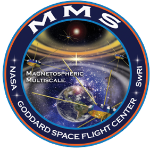The geomagnetic storm interval that occurred during May 2024 represents the most significant period of severe space weather during solar cycle 25 to date, providing a unique opportunity to understand the behaviour of the magnetosphere under extreme conditions. This interval was extremely well observed, with a variety of missions measuring the solar wind input, the dayside magnetospheric boundaries, the dynamics of the magnetotail and the ionospheric response. Using a fortuitous conjunction of spacecraft, we examine in detail the response of the magnetosphere to a solar wind pressure pulse that was observed on 11 May 2024 at approximately 09:30 UT by THEMIS-C in the upstream solar wind. This occurred during the recovery phase of the ongoing geomagnetic storm and is thought to have triggered near-Earth tail reconnection (Liu et al. 2024).
Magnetospheric Multiscale (MMS) was located in the vicinity of the Earth's bow shock, and the MMS data is used to constrain and characterise the passage of the pressure pulse, the subsequent magnetopause motion, and the response of the bow shock. This is augmented by simultaneous magnetic field measurements made by THEMIS-A and THEMIS-E also made in the vicinity of the bow shock. These data are then placed in the context of data from GOES-16 and GOES-18 and previously reported observations of near-Earth tail current sheet thinning. Finally, magnetic field data from the RadCube technology demonstration CubeSat in low Earth orbit is used to characterise the nature of the field-aligned currents, finding a very extended region of FAC activity on the nightside which suggests the formation of a complex and structured substorm current wedge.

 PDF version
PDF version
